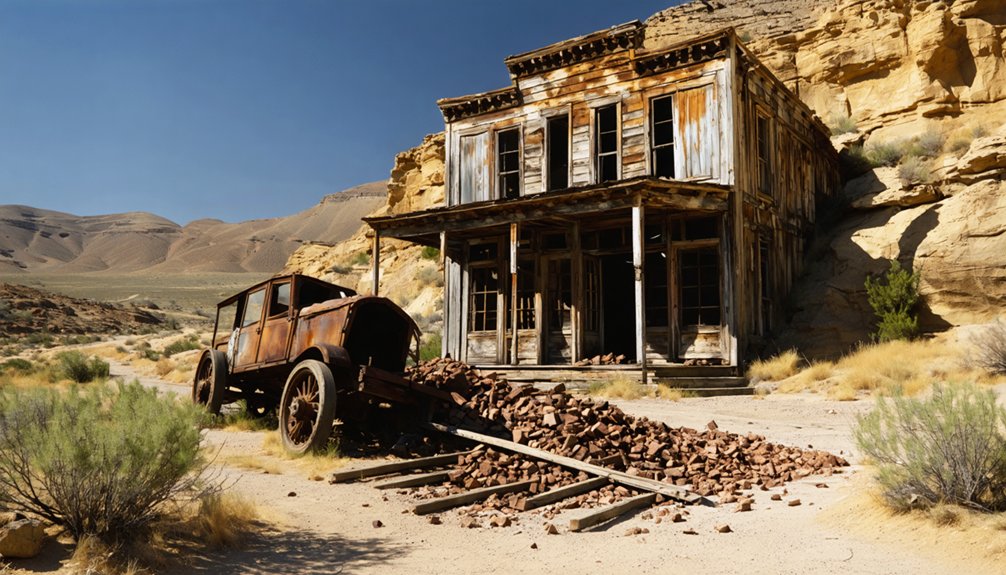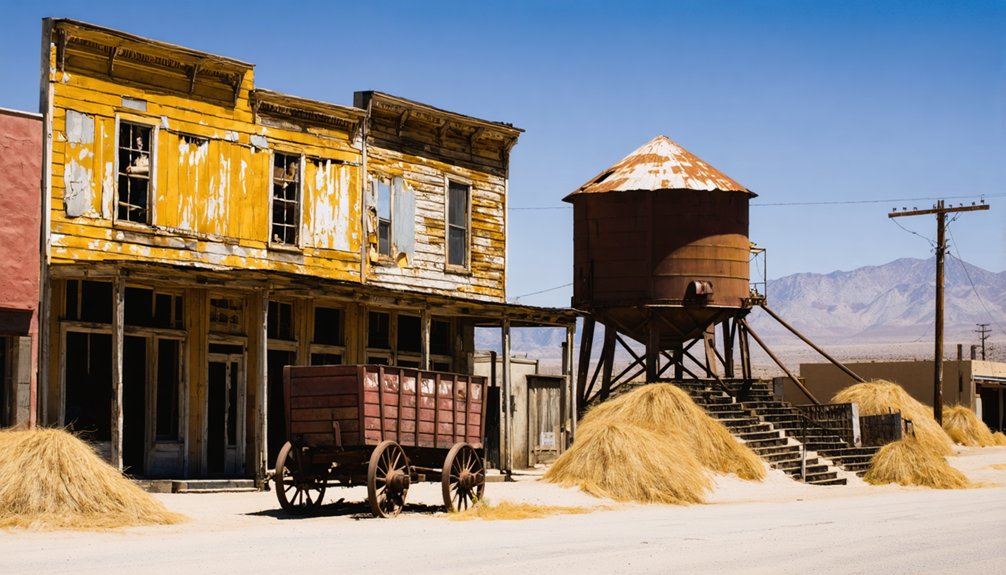You’ll find Balaklava Hill among California’s canyon regions, where silver ore discovery sparked a mining boom in the mid-1800s. The town quickly established seven saloons and multiple hotels by 1878, with mining operations evolving from basic prospect holes to sophisticated underground systems. After promising initial yields, the 1880s brought declining ore production, leading to widespread closures and exodus. Today, only scattered foundations remain, though the site’s complex history of outlaws and tragedy runs deeper than its visible ruins.
Key Takeaways
- Balaklava Hill was a silver mining settlement established during California’s 1800s mining boom, experiencing rapid growth followed by decline.
- The town featured seven saloons, multiple hotels, and mining operations using electric hoists and air compressors by 1878.
- Mining accidents, toxic exposure, and environmental hazards led to numerous deaths and eventually contributed to the town’s abandonment.
- Only foundational remains and scattered rubble exist today, with native vegetation reclaiming most of the former settlement area.
- Modern visitors need high-clearance vehicles to access the site, where photography and historical exploration opportunities remain available.
The Mining Boom Years
When silver ore was first discovered in California’s canyon regions during the mid to late 1800s, prospectors rushed to stake their claims in what would become Balaklava Hill.
Initial assays showed promising yields, but you’d soon discover the ore samples were misleadingly rich, often containing complex mixtures of silver chloride, free gold, and ruby silver that required advanced processing.
Mining techniques evolved from basic prospect holes to sophisticated underground operations.
You’d find miners using 20-50 horsepower electric hoists and air compressors to power their drills and transport ore through extensive networks of shafts and drifts.
By late 1878, the region had established seven saloons and multiple hotels to serve the growing mining community.
The operation benefited from Remi Nadeau’s freighting which enhanced transportation of materials to and from the mines.
Ore processing proved challenging, requiring shipment to distant smelters via a complex transport chain of burros, wagons, and rail.
Despite these hurdles, some operations flourished through mechanization and improved milling technologies.
Daily Life in the Wild West
Life in Balaklava Hill centered around the demanding rhythms of mining operations, where you’d find residents adapting to harsh conditions through a network of wooden structures and basic amenities.
Community gatherings in saloons and multi-purpose buildings helped forge bonds among the transient population, offering respite from daily hardships like limited plumbing and minimal heating during bitter mountain winters. Much like the infamous town of Bodie, the area attracted thousands seeking fortune after rich gold deposits were discovered. Similar to Randsburg’s peak, the town saw a population that reached 2,500 residents during its most prosperous period.
- You’d spend your days working in mines or supporting trades like blacksmithing and carpentry.
- Your evenings might involve card games at the saloon, which doubled as the town’s news center.
- You’d rely on general stores for necessities, though prices ran high due to difficult transport.
- Your home would likely be a simple cabin or boarding house with wood stove heating.
- You’d navigate unpaved roads on foot or horseback, dealing with seasonal weather challenges.
Notable Characters and Events
You’ll find that Balaklava Hill’s history mirrors other California ghost towns with its share of notorious characters, including local bandits who preyed on gold shipments and solitary miners.
Mining camp tragedies were commonplace, as workers faced deadly accidents from collapsing shafts and equipment failures while pursuing their fortunes in dangerous conditions. Like many settlements dotting Route 66, the town represented both opportunity and peril for those seeking a new life in the West.
These incidents shaped the town’s grim reputation, contributing to its eventual abandonment as miners sought safer opportunities elsewhere, much like the mass exodus that affected Bodie and similar settlements in the 1880s. Much like Calico’s fate, the town’s decline accelerated when plummeting silver prices made mining operations unprofitable.
Infamous Local Outlaws
During the late 1800s, Balaklava Hill and its surrounding regions attracted numerous notorious outlaws who exploited the area’s rugged terrain and isolated location.
From the Mendocino Outlaws’ violent confrontations with Sheriff Standley to Juan Flores’ deadly raids in Southern California, these criminals established a complex network of hideouts and sympathizers throughout the region. The skilled lawman George Swain successfully captured outlaw Eduardo Gallego through a daring surprise attack. Flores launched a drunken looting spree at San Juan Capistrano, murdering a German shopkeeper and wounding others.
- Hidden jacales in the Black Hills served as secure bases for bandits like Jack Powers and Tom Bell.
- Local ranchers often collaborated with outlaws, fencing stolen goods and concealing rustled livestock.
- The Mendocino Outlaws sparked a multi-county manhunt after killing two posse members in 1879.
- Sheriff Barton’s death at Barranco de los Alisos marked one of California’s bloodiest law enforcement ambushes.
- Even Jesse James reportedly made appearances in California, connecting the region to broader outlaw networks.
Mining Camp Tragedies
While gold and copper mining brought wealth to Balaklava Hill and surrounding regions, these operations also spawned numerous tragedies that shaped the area’s dark history.
Today, the mine’s portals continue to create environmental hazards with acid mine drainage seeping into local waterways.
In the early 1900s, mining accidents like cave-ins and explosions claimed countless lives due to primitive safety measures and outdated technology. You’d find miners battling severe health hazards daily, including toxic exposure to sulfur and pyrite dust that led to devastating respiratory diseases.
The Montgomery brothers revived mining operations in 1903, bringing brief prosperity before operations declined again.
The region’s challenges extended beyond the mines themselves. Devastating floods swept through Pleasant Canyon in 1901, destroying essential infrastructure.
Multiple fires ravaged Mokelumne Hill between 1854 and 1874, while violent claim disputes erupted in the “French War” of 1851.
When major operations like the Ratcliff Consolidated Mine shut down in 1903, entire communities faced sudden economic collapse.
Architecture and Infrastructure
As Balaklava Hill grew from a mining settlement into a functioning town, its architecture reflected both the practical needs of survival and the available materials at hand. The building techniques focused on wooden construction, with some stone and brick elements added for structural durability.
You’ll find that the town’s infrastructure was designed to withstand harsh winters, with temperatures plunging to 40 degrees below zero.
- Water-powered sawmills served as the backbone of construction, producing essential lumber
- Main buildings clustered around key intersections of Green and Main streets
- Industrial structures featured fire-resistant materials and enhanced durability
- Essential services like the school, church, and stores formed the town’s central hub
- Blacksmith shops and hotels emerged as crucial service buildings supporting daily operations
The Town’s Decline

The robust infrastructure of Balaklava Hill’s prime years couldn’t withstand the economic forces that would seal its fate.
You’ll find the town’s decline followed a familiar pattern of 1880s mining communities: declining ore yields triggered severe economic repercussions, leading to widespread business closures and a mass exodus of workers.
Population dynamics shifted dramatically as the town’s numbers plummeted, with devastating fires in 1890 and 1932 accelerating the downward spiral.
You’d have witnessed the closure of schools, hotels, and social institutions as families departed for more promising opportunities.
World War II’s government-mandated mine closures dealt another blow, while environmental challenges like water scarcity and mining pollution made life increasingly unsustainable.
The combination of resource depletion, regulatory pressures, and changing transportation routes ultimately transformed this once-bustling mining town into a ghost town.
Modern-Day Exploration
When you’re planning to explore Balaklava Hill Ghost Town, you’ll need a high-clearance vehicle to navigate the unpaved roads leading to the site, especially after adverse weather conditions.
You should proceed with caution at the site itself, as the ground can be unstable around old foundations, and there’s no cell phone coverage for emergencies.
The remote location offers a quiet setting for photography and historical exploration, but you’ll find only foundational remains and rubble, with no standing structures or visitor amenities.
Safety and Access Tips
Modern explorers seeking to visit Balaklava Hill ghost town must prioritize thorough preparation and safety measures before commencing their journey. You’ll need to verify road conditions and bring a high-clearance vehicle, as the terrain can be challenging.
Pack essential safety gear including sturdy boots, layered clothing, and emergency supplies.
- Bring detailed maps and GPS devices with offline capabilities due to unreliable cell service.
- Pack plenty of water, food, and an extensive first-aid kit.
- Use a 4×4 vehicle and check weather conditions before departure.
- Inform a trusted contact of your travel plans and expected return time.
- Carry emergency communication devices like satellite phones or personal locator beacons.
Remember to respect the site’s historical integrity by staying on established paths and avoiding artifact removal.
Visit during daylight hours and be prepared for rapid weather changes common in the area.
Current Site Conditions
Today’s explorers visiting Balaklava Hill will find a dramatically different landscape from its bustling mining-era past. Native vegetation has largely reclaimed the site, with oak woodlands and chaparral obscuring most traces of the former settlement.
You’ll encounter minimal site preservation, as no standing structures remain – only scattered foundations and mining debris hint at the area’s historical significance.
The environmental impact of time and weather continues to reshape the terrain. While you might spot occasional artifacts like rusted metal or broken glass, these remnants are becoming increasingly scarce.
The absence of maintained trails or interpretive markers means you’ll need to rely on your own navigation skills. The site’s natural rewilding process provides excellent wildlife viewing opportunities, though it makes historical feature identification more challenging.
Frequently Asked Questions
Were Any Paranormal Activities or Ghost Sightings Reported in Balaklava Hill?
You won’t find any documented ghost encounters or spectral sightings here – there’s no evidence of paranormal activity. The place hasn’t yielded any confirmed supernatural reports in historical records.
What Native American Tribes Originally Inhabited the Area Before Mining Began?
You’ll find the Sierra Miwok were the primary native tribes in this area, maintaining their rich cultural heritage through village-based communities until the Gold Rush displaced them from their ancestral lands.
How Did the Town Get Its Unusual Name “Balaklava”?
You’ll find the Balaklava origin stems from the famous 1854 Crimean War battle, as settlers commonly named mining towns after significant battles, reflecting the era’s trend of commemorating historical events.
Were There Any Major Natural Disasters That Affected the Town?
Like a gentle breeze in the desert, you’ll find no major natural disasters struck this place. Historical records don’t show any earthquake impact or flood damage affecting the town’s existence.
What Happened to the Cemetery and Are There Marked Graves Today?
You won’t find any marked gravestones or formal cemetery preservation efforts today – there’s no evidence a designated cemetery ever existed, and any informal burial sites have been lost to time and desert conditions.
References
- https://secretlosangeles.com/bodie-ghost-town-california/
- https://www.youtube.com/watch?v=2Foz-2R_mH8
- https://patch.com/california/banning-beaumont/13-ghost-towns-explore-california
- https://en.wikipedia.org/wiki/List_of_ghost_towns_in_California
- https://www.islands.com/1977075/bagdad-siberia-california-ruins-route-66-abandoned-ghost-towns/
- https://tredcred.com/blogs/trail/ghost-town-overlanding-off-roading-through-california-s-abandoned-history
- https://www.ochistoryland.com/silverado
- https://www.publiclandsforthepeople.org/wp-content/uploads/2015/06/Desert-Fever-History-of-Mining-in-the-CDCA.pdf
- https://vredenburgh.org/mining_history/pages/west_mojave_desert.htm
- https://www.calaverashistory.org/mining



